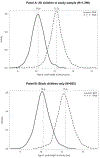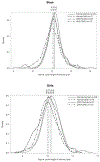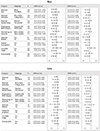Trajectory of Body Mass Index from Ages 2 to 7 Years and Age at Peak Height Velocity in Boys and Girls
- PMID: 33253732
- PMCID: PMC7982280
- DOI: 10.1016/j.jpeds.2020.11.047
Trajectory of Body Mass Index from Ages 2 to 7 Years and Age at Peak Height Velocity in Boys and Girls
Abstract
Objective: To examine the associations between body mass index (BMI) at 2-4 years and 5-7 years and age at peak height velocity (APHV), an objective measure of pubertal timing, among boys and girls from predominantly racial minorities in the US that have been historically underrepresented in this research topic.
Study design: This study included 1296 mother-child dyads from the Boston Birth Cohort, a predominantly Black and low-income cohort enrolled at birth and followed prospectively during 1998-2018. The exposure was overweight or obesity, based on Centers for Disease Control and Prevention reference standards. The outcome was APHV, derived using a mixed effects growth curve model. Multiple regression was used to estimate the overweight or obesity-APHV association and control for confounders.
Results: Obesity at 2-4 years was associated with earlier APHV in boys (B in years, -0.19; 95% CI, -0.35 to -0.03) and girls (B, -0.22; 95% CI, -0.37 to -0.07). Obesity at 5-7 years was associated with earlier APHV in boys (B, -0.18; 95% CI, -0.32 to -0.03), whereas overweight and obesity at 5-7 years were both associated with earlier APHV in girls (overweight: B, -0.24; 95% CI, -0.40 to -0.08; obesity: B, -0.27; 95% CI, -0.40 to -0.13). With BMI trajectory, boys with persistent overweight or obesity and girls with overweight or obesity at 5-7 years, irrespective of overweight or obesity status at 2-4 years, had earlier APHV.
Conclusions: This prospective birth cohort study found that overweight or obesity during 2-7 years was associated with earlier pubertal onset in both boys and girls. The BMI trajectory analyses further suggest that reversal of overweight or obesity may halt the progression toward early puberty.
Keywords: childhood obesity; endocrinology; epidemiology; health disparities; obesity; puberty; puberty onset; racial disparities.
Copyright © 2020 Elsevier Inc. All rights reserved.
Figures




Comment in
-
Obesity in both boys and girls associated with earlier pubertal timing.J Pediatr. 2021 Jul;234:286-288. doi: 10.1016/j.jpeds.2021.04.053. J Pediatr. 2021. PMID: 34172166 No abstract available.
Similar articles
-
Association between height growth patterns in puberty and stature in late adolescence: A longitudinal analysis in chinese children and adolescents from 2006 to 2016.Front Endocrinol (Lausanne). 2022 Jul 22;13:882840. doi: 10.3389/fendo.2022.882840. eCollection 2022. Front Endocrinol (Lausanne). 2022. PMID: 35937794 Free PMC article.
-
Maternal pre-pregnancy overweight/obesity, in-utero exposure to toxic heavy metals, and offspring age at peak height velocity: A prospective birth cohort study.Environ Res. 2025 Aug 15;279(Pt 2):121829. doi: 10.1016/j.envres.2025.121829. Epub 2025 May 13. Environ Res. 2025. PMID: 40373995
-
Analysis of Early-Life Growth and Age at Pubertal Onset in US Children.JAMA Netw Open. 2022 Feb 1;5(2):e2146873. doi: 10.1001/jamanetworkopen.2021.46873. JAMA Netw Open. 2022. PMID: 35119461 Free PMC article.
-
New approaches to obtaining individual peak height velocity and age at peak height velocity from the SITAR model.Comput Methods Programs Biomed. 2018 Sep;163:79-85. doi: 10.1016/j.cmpb.2018.05.030. Epub 2018 Jun 1. Comput Methods Programs Biomed. 2018. PMID: 30119859 Review.
-
Overweight/Obesity in Childhood and the Risk of Early Puberty: A Systematic Review and Meta-Analysis.Front Pediatr. 2022 Jun 3;10:795596. doi: 10.3389/fped.2022.795596. eCollection 2022. Front Pediatr. 2022. PMID: 35722495 Free PMC article.
Cited by
-
Prepubertal BMI, pubertal growth patterns, and long-term BMI: Results from a longitudinal analysis in Chinese children and adolescents from 2005 to 2016.Eur J Clin Nutr. 2022 Oct;76(10):1432-1439. doi: 10.1038/s41430-022-01133-2. Epub 2022 May 6. Eur J Clin Nutr. 2022. PMID: 35523866
-
Trajectory of body mass index and height changes from childhood to adolescence: a nationwide birth cohort in Japan.Sci Rep. 2021 Nov 26;11(1):23004. doi: 10.1038/s41598-021-02464-z. Sci Rep. 2021. PMID: 34837002 Free PMC article.
-
Association between height growth patterns in puberty and stature in late adolescence: A longitudinal analysis in chinese children and adolescents from 2006 to 2016.Front Endocrinol (Lausanne). 2022 Jul 22;13:882840. doi: 10.3389/fendo.2022.882840. eCollection 2022. Front Endocrinol (Lausanne). 2022. PMID: 35937794 Free PMC article.
-
Association between infant breastfeeding practices and timing of peak height velocity: A nationwide longitudinal survey in Japan.Pediatr Res. 2023 Nov;94(5):1845-1854. doi: 10.1038/s41390-023-02706-y. Epub 2023 Jul 3. Pediatr Res. 2023. PMID: 37400541 Free PMC article.
-
Endocrine Health and Health Care Disparities in the Pediatric and Sexual and Gender Minority Populations: An Endocrine Society Scientific Statement.J Clin Endocrinol Metab. 2023 Jun 16;108(7):1533-1584. doi: 10.1210/clinem/dgad124. J Clin Endocrinol Metab. 2023. PMID: 37191578 Free PMC article.
References
-
- Cooper GS, Ephross SA, Weinberg CR, Baird DD, Whelan EA, Sandler DP. Menstrual and reproductive risk factors for ischemic heart disease. Epidemiol Camb Mass 1999;10:255–9. - PubMed
Publication types
MeSH terms
Grants and funding
LinkOut - more resources
Full Text Sources
Other Literature Sources
Medical

